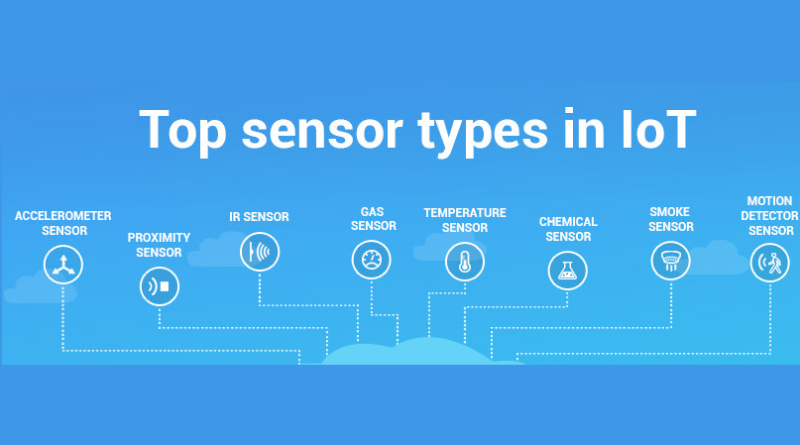Commonly used Sensors in IoT
In this post, We talk about Basic “Commonly used Sensors in IoT” that are used for IoT projects. So we are trying to provide a list of basic sensors and actuators for build any IoT projects.
The data can be real-time, which includes the current temperature, pressure or humidity. It can also sense the objects and calculate the distance between them. For each purpose, there are sensors available in the market. In this article, we shall discuss various sensors and their applications, which can be used in your DIY IoT projects.

Above picture is an Equation of Internet of things. IoT Sensors and Actuators plays main role in any IoT Projects. Without IoT Sensors and Actuators, there’s no IoT.
Here is the list of IoT Sensors most commonly used in the IoT devices,
- Temperature Sensor
- Pressure Sensor
- Proximity Sensor
- Accelerometer and Gyroscope Sensor
- IR Sensor
- Optical Sensor
- Gas Sensor
- Smoke Sensor
Temperature Sensor and Humidity Sensor
A Temperature Sensor senses and measures the temperature and converts it into an electrical signal. They have a major role in Environment, Agriculture and Industries. For example, these sensors can detect the temperature of the soil, which is more helpful in the production of crops. There are many types of temperature sensors and the commonly used are NTC thermistor, Resistance Temperature Detectors RTDs, Thermocouples and Thermopiles. They are efficient, easy to install and reliable that responds to the human activity. The RTDs work on the correlation between the metals and the temperature, as the resistance of the device is directly proportional to the temperature. The widely used DHT 11 is the temperature and humidity sensor, which is the basic, low-cost, digital and capacitive sensor. No analog pins are required for this sensor. You can buy the sensor from Adafruit which has many offers on this.
DHT11:
The DHT11 is a basic, ultra low-cost digital temperature and humidity sensor. It uses a capacitive humidity sensor and a thermistor to measure the surrounding air, and spits out a digital signal on the data pin (no analog input pins needed). Its fairly simple to use, but requires careful timing to grab data. The only real downside of this sensor is you can only get new data from it once every 2 seconds, so when using our library, sensor readings can be up to 2 seconds old.
DHT22:
The DHT22 is a basic, low-cost digital temperature and humidity sensor. It uses a capacitive humidity sensor and a thermistor to measure the surrounding air, and spits out a digital signal on the data pin (no analog input pins needed). It’s fairly simple to use, but requires careful timing to grab data. The only real downside of this sensor is you can only get new data from it once every 2 seconds, so when using our library, sensor readings can be up to 2 seconds old.
Simply connect the first pin on the left to 3-5V power, the second pin to your data input pin and the rightmost pin to ground. Although it uses a single-wire to send data it is not Dallas One Wire compatible! If you want multiple sensors, each one must have its own data pin.
Recommended: DHT11 vs DHT22: Overview
Temperature, Humidity and Barometric Pressure Sensors:
BME280:
The BME280 is as combined digital humidity, pressure and temperature sensor based on proven sensing principles. Its small dimensions and its low power consumption allow the implementation in battery driven devices such as handsets, GPS modules or watches. The BME280 achieves high performance in all applications requiring humidity and pressure measurement.
Temperature, Altitude and Barometric Pressure Sensors:
BMP180:
The BME280 is an integrated environmental sensor developed specifically for mobile applications where size and low power consumption are key design constraints. The unit combines individual high linearity, high accuracy sensors for pressure, humidity and temperature in an 8-pin metal-lid 2.5 x 2.5 x 0.93 mm³ LGA package, designed for low current consumption (3.6 μA @1Hz), long term stability and high EMC robustness.
The humidity sensor features an extremely fast response time which supports performance requirements for emerging applications such as context awareness, and high accuracy over a wide temperature range. The pressure sensor is an absolute barometric pressure sensor with features exceptionally high accuracy and resolution at very low noise. The integrated temperature sensor has been optimized for very low noise and high resolution. It is primarily used for temperature compensation of the pressure and humidity sensors, and can also be used for estimating ambient temperature.
MPL3115A2:
The MPL3115A2 is a compact, piezoresistive, absolute pressure sensor with an I2Cdigital interface. MPL3115A2 has a wide operating range of 20 kPa to 110 kPa, a rangethat covers all surface elevations on earth. The MEMS is temperature compensatedutilizing an on-chip temperature sensor. The pressure and temperature data is fed intoa high resolution ADC to provide fully compensated and digitized outputs for pressurein Pascals and temperature in °C.
Distance / Proximity Sensors:
PIR Sensor:
PIR sensors allow you to sense motion, almost always used to detect whether a human has moved in or out of the sensors range. They are small, inexpensive, low-power, easy to use and don’t wear out. For that reason they are commonly found in appliances and gadgets used in homes or businesses. They are often referred to as PIR, “Passive Infrared”, “Pyroelectric”, or “IR motion” sensors.
HC-SR04 (Ultrasonic Distance Sensor):
This is the HC-SR04 ultrasonic distance sensor. This economical sensor provides 2cm to 400cm of non-contact measurement functionality with a ranging accuracy that can reach up to 3mm. Each HC-SR04 module includes an ultrasonic transmitter, a receiver and a control circuit.
GP2Y0A02YK0F (IR Distance Sensor):
Infrared proximity sensor made by Sharp. Part # GP2Y0A02YK0F has an analog output that varies from 2.8V at 15cm to 0.4V at 150cm with a supply voltage between 4.5 and 5.5VDC. The sensor has a Japanese Solderless Terminal (JST) Connector. We recommend purchasing the related pigtail below or soldering wires directly to the back of the module.
Accelerometer and Gyroscope Sensor
The difference between Accelerometer and the gyroscope is accelerometer measures linear acceleration based on vibration whereas, the gyroscope is intended to determine an angular position based on the principle of the rigidity of space. Accelerometers in mobile phones are used to detect the orientation of the phone. The gyroscope, adds an additional dimension to the information supplied by the accelerometer by tracking rotation or twist. A 3D gyroscope has three gyroscopic sensors mounted orthogonally. Accelerometers and gyroscopes are the sensors of choice for acquiring acceleration and rotational information in drones, cell phones, automobiles, airplanes, and mobile IoT devices.
L3G4200D (3-Axis Digital Gyroscope):
This sensor is a carrier/breakout board for the ST L3G4200D three-axis gyroscope, which measures the angular rates of rotation about the roll (X), pitch (Y), and yaw (Z) axes. Angular velocity measurements with a configurable range of ±250°/s, ±500°/s, or ±2000°/s can be read through a digital I²C or SPI interface. The board operates from 2.5–5.5 V and has a 0.1″ pin spacing.
MPU-6050 (3-Axis Digital Gyroscope):
MPU6050 sensor module is complete 6-axis Motion Tracking Device. It combines 3-axis Gyroscope, 3-axis Accelerometer and Digital Motion Processor all in small package. Also, it has additional feature of on-chip Temperature sensor. It has I2C bus interface to communicate with the microcontrollers.
ITG3205 (3-Axis Digital Gyroscope):
The ITG-3200 features three 16-bit analog-to-digital converters (ADCs) for digitizing the gyro outputs, a user-selectable internal low-pass filter bandwidth, and a Fast-Mode I2C (400kHz) interface. Additional features include an embedded temperature sensor and a 2% accurate internal oscillator.
HMC5883L (3-Axis Digital Compass):
HMC5883L is Honeywell’s 3-axis digital compass. Communication with the HMC5883L is simple and all done through an I2C interface. There is no on-board regulator, so a regulated voltage of 2.16-3.6VDC should be supplied.
FGPMMOPA6C / MT3339 (GPS Module):
The GlobalTop FGPMMOPA6C is an ultra‐compact POT (Patch On Top) GPS Module, The module utilizes the MediaTek new generation GPS Chipset MT3339 that achieves the industry’s highest level of sensitivity (‐165dBm ) and instant Time‐to‐First Fix (TTFF) with lowest power consumption for precise GPS signal processing to give the ultra‐precise positioning under low receptive, high velocity conditions.
Infrared Sensors
An Infrared Sensor is an electronic device, which senses certain characteristics of its surroundings by emitting Infrared radiation. It has the ability to measure the heat being emitted by an object and also measures the distance. It has been implemented in various applications. It is used in Radiation thermometers depend on the material of the object. IR sensors are also used in Flame monitors and moisture analysis. IR sensors are used in gas analyzers which use absorption characteristics of gases in the IR region. Two types of methods are used to measure the density of gas such as dispersive and non dispersive. IR imaging devicesare used for thermal imagers and also for night vision.
Optical Sensors
The Optical Sensors convert light rays into an electronic signal, it measures a physical quantity of light and transforms into a form which is readable, maybe digital form. It detects the electromagnetic energy and sends the results to the units. It involves no optical fibers. It is a great boon to the cameras in mobile phones. Also, it is used in mining, chemical factories, refineries, etc. LASER and LED are the two different types of light source. Optical sensors are integral parts of many common devices, including computers, copy machines (Xerox) and light fixtures that turn on automatically in the dark. And some of the common applications include alarm systems, synchros for photographic flashes and systems that can detect the presence of objects.
Raspberry Pi Official Camera Module:
This camera module is capable of 1080p video and still images and connects directly to your Raspberry Pi. Connect the included ribbon cable to the CSI (Camera Serial Interface) port on your Raspberry Pi, boot up the latest version of Raspbian and you are good to go.
OV7670/OV7171 (640×480 VGA CMOS Camera):
The ov7670 is an image sensor manufactured by Omnivision. It can provide the full functionality of a single-chip VGA camera and image processor in a small footprint package. The OV7670/OV7171 provides full-frame, sub-sampled or windowed 8-bit images in a wide range of formats, controlled through the Serial Camera Control Bus (SCCB) interface.
Light Sensors:
LDR:
A photoresistor (or light-dependent resistor, LDR, or photocell) is a light-controlled variable resistor. The resistance of a photoresistor decreases with increasing incident light intensity; in other words, it exhibits photoconductivity.
Photodiode:
Phototransistor:
Smoke Sensor or Gas Sensor
A smoke sensor detects smoke and its level of attainment. Now a days, the manufacturers of the sensor implement it with a voice alarm through ALEXA, also notifies in our smartphones. The smoke sensor if of two types, Optical smoke sensor, and the ionization smoke sensor. The optical smoke sensor also called the photoelectric smoke alarms works using the light scattering principle. The alarm contains a pulsed Infrared LED which pulses a beam of light into the sensor chamber every 10seconds to check for smoke particles.
A Gas Sensor or a Gas detector is a device that detects the gas in an area, which is very helpful in safety systems. It usually detects a gas leak in an area, that results are sent to a control system or a microcontroller, that finally shuts down. it can detect combustible, flammable and toxic gases.
There are several different sensors that can be installed to detect hazardous gases in a residence. Carbon monoxide is very dangerous, but odorless, colorless gas, making it difficult for humans to detect. Carbon monoxide detectors can be purchased for around US$20–60.
This sensor is used in air quality control equipment for buildings/offices, are suitable for detecting of NH3,NOx, alcohol, Benzene, smoke,CO2 ,etc.
MQ-2 (LPG, Butane, Propane, Methane, Ethanol, Hydrogen, Smoke Sensor):
MQ – 2 is a flammable gas and smoke sensor detects the concentrations of combustible gas in the air and outputs its reading as an analog voltage. It is used for home or factory gas leakage monitoring devices, suitable for liquefied petroleum gas, butane, propane, methane, ethanol, hydrogen, smoke and other monitoring devices.
MQ-3 (Alcohol Sensor):
This module is made using Alcohol Gas Sensor MQ3. It is a low cost semiconductor sensor which can detect the presence of alcohol gases at concentrations from 0.05 mg/L to 10 mg/L. The sensitive material used for this sensor is SnO2, whose conductivity is lower in clean air. It’s conductivity increases as the concentration of alcohol gases increases. It has high sensitivity to alcohol and has a good resistance to disturbances due to smoke, vapor and gasoline. This module provides both digital and analog outputs. MQ3 alcohol sensor module can be easily interfaced with Microcontrollers, Arduino Boards, Raspberry Pi etc.
MQ-6 (LPG, Iso-Butane, Propane):
This propane gas sensor detects the concentrations of LPG, isobutane, and propane in the air and ouputs its reading as an analog voltage. The sensor can measure concentrations of 300 to 10,000 ppm.The sensor can operate at temperatures from -10 to 50°C and consumes less than 150 mA at 5 V.
MQ-7 (Carbon Monoxide Sensor):
This is a simple-to-use Carbon Monoxide (CO) sensor, suitable for sensing CO concentrations in the air. The MQ-7 can detect CO-gas concentrations anywhere from 20 to 2000ppm.
This sensor has a high sensitivity and fast response time. The sensor’s output is an analog resistance. The drive circuit is very simple; all you need to do is power the heater coil with 5V, add a load resistance, and connect the output to an ADC.
Magnetic Sensors:
Reed Switch:
The reed switch is an electrical switch operated by an applied magnetic field. It was invented at Bell Telephone Laboratories in 1936 by W. B. Ellwood. When the device is exposed to a magnetic field, the two ferrous materials inside the switch pull together and the switch closes. When the magnetic field is removed, the reeds separate and the switch opens.
Magnetic Switch (Magnetic Door / Window Sensor):
Magnetic Switch is a small reed switch assembly specifically designed to alert you when doors, drawers, or any other aperture opens. These types of switches are primarily used in home security systems. One half of the assembly set on a window or door frame and the other attached to the window or door itself. When the switch set is separated from each other the contact is broken and triggers an alarm.
US1881 (Hall Latch):
The US1881 is a Hall-effect latch designed in mixed signal CMOS technology. The device integrates a voltage regulator, Hall sensor with dynamic offset cancellation system, Schmitt trigger and an open-drain output driver, all in a single package.
SCT-013-000 (Non-invasive AC Current Sensor):
The split core type sensor, is particularly suitable for DIY projects. It can be clipped straight on to either the live or neutral wire coming into the building without having to do any high voltage electrical work. The measured current is alternative, and the sensor is calibrated to measure a max of 100A AC. 100A is the RMS value of the maximum current the sensor can handle.
Thanks for reading. If you like this post “Commonly used Sensors in IoT” probably you might like my next ones, so please support me by subscribing my blog.
We have other tutorials with ESP32 that you may find useful:
- Dynamic WLAN configuration for ESP32 Board | AutoConnect
- ESP32 BLE on Arduino IDE with UART Test
- ESP32 Bluetooth Low Energy (BLE) on Arduino IDE
- ArduinoOTA ESP32: Wi-Fi (OTA) Wireless Update from the Arduino IDE
- ESP32 with LoRa using Arduino IDE
- How To Use Grove-LCD RGB Backlight with NodeMCU
- NodeMcu to DHT Interface in Blynk app
- How To ON/OFF a bulb by Google voice assistant
- Arduino IDE | Arduino | Open Source Hardware/Softawre | Arduino Vs RPi
- WiFi LoRA 32 (V2) ESP32 | Overview | Introduction
- DHT11 sensor with ESP8266/NodeMCU using Arduino IDE
- Arduino Support for ESP8266 with simple test code





Pingback: Commonly used Sensors in IoT — IoTbyHVM – Bits & Bytes of IoT – hashstacks